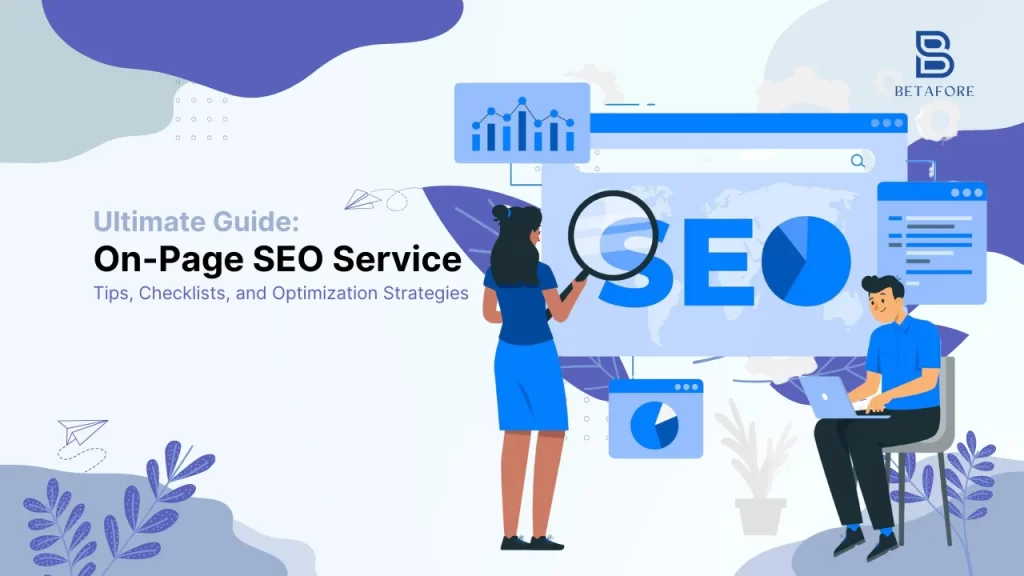
On-page SEO services help your website be more optimized for users and search engines. Every effective SEO strategy boosts your website’s appearance in search results and improves its usability for users on various devices. In this easy guide to on page SEO services, we will look at what makes it important, how to build and adopt an on-page SEO strategy, and where you need the most improvements. Let’s begin the story.
Table of Contents
Understanding On-Page SEO
What is On-Page SEO?
On-page is an essential SEO practice that includes optimizing the content for search engines with proper keyword optimization, title tag optimization, internal links, schema markup, page speed optimization, etc. When search engines like Yahoo and Google were introduced in the last decade of the 1900s, the only way to perform any kind of SEO was through onpage activities.
On page SEO Importance
From every perspective, Google is the most used search engine. In May 2020, Google introduced Core Web Vitals. Since then, the search engine has considered Core Web Vitals as a ranking signal. It’s a set of metrics that measure the real-world user experience for loading performance, interactivity, and visual stability of the page.
These matrices illustrate the significance of on page SEO optimization, clearly demonstrating the importance of optimizing content and web pages for search engines. For a better understanding, please check the comparison chart provided below.
| Core Web Vitals | What It Measures | On-Page SEO Factor | How It Helps SEO |
| Largest Contentful Paint (LCP) | How fast the biggest thing on your page (like an image) loads. | Page Load Speed | Faster loading pages keep visitors happy, which helps your site rank better. |
| First Input Delay (FID) | How quickly your page responds when someone clicks or taps. | Page Interactivity | A fast response keeps users engaged and improves SEO rankings. |
| Cumulative Layout Shift (CLS) | How stable your page is while loading (no unexpected shifts). | Page Layout Stability | A stable page keeps users from clicking the wrong thing, leading to better SEO. |
| Image Optimization | How well images are resized and compressed for faster loading. | Optimized Media | Smaller, faster-loading images make your site faster, which improves SEO. |
| JavaScript Optimization | How fast your page responds by using efficient JavaScript. | Code Efficiency | Clean, fast code makes your page load faster and improves SEO. |
| Mobile Friendliness | How well your site works on mobile devices. without slowing down the page. | Mobile SEO | A smooth mobile experience improves your ranking on mobile search results. |
On page SEO service also focuses on internal linking. Internal links make it easier for Google to organize and comprehend every page on your site, and they also assist visitors in finding and accessing your content. And they help users navigate your website and find your content. The anchor text for the internal links is also important for both users and search engines.
These are some of the key importance of on page SEO service. As we progress through this blog, you will gain a better understanding of the importance of on-page SEO.
Essential On-Page SEO Checklist
✅ Title Tags and Meta Descriptions
- Unique, keyword-rich title tags (under 60 characters)
- Compelling meta descriptions (under 160 characters)
✅ Header Tags (H1, H2, H3…)
- Use one H1 tag for the main heading
- Structure with H2 and H3 for subheadings
- Include keywords naturally
✅ URL Structure
- Short, descriptive, keyword-rich URLs
- Use hyphens (-) to separate words
✅ Internal Linking
- Link to relevant pages within your site
- Use descriptive anchor text with keywords
✅ Image Optimization
- Compress images for faster loading
- Add descriptive alt text with relevant keywords
✅ Content Quality
- High-quality, original content
- Natural keyword inclusion, no stuffing
- Engaging, well-structured, and readable
✅ Mobile Responsiveness
- Fully responsive design
- Mobile-friendly navigation and fast load times
Get Your Custom Checklist for On-page Optimization:
Proven On-Page SEO Tips
On page SEO stands as one of the most extensively researched and experimented concepts among SEOs, web masters, and marketers alike. It covers a vast array of best practices, yet there are several proven on-page SEO steps that can yield positive SEO results and elevate your website’s ranking on the SERP (search engine result pages). Here we have listed the best on-page SEO tips together: Here we have listed the best on-page SEO tips together:
1. Publish Helpful Content
Creating detailed, original, and useful content is key to improving your website’s on page SEO service performance. Google and other search engines aim to offer all the information a user might need on one page, so your content should reflect this goal.
Also, each piece of content should be unique. While ideas may not be new every day, your content should have unique wording that will not be flagged as plagiarized by at least three different plagiarism detection tools.
2. Optimize content for SEO
Starting with on page SEO service means more than just writing good content. It’s about carefully using keywords, organizing your page well, and showing search engines that your page is a reliable source on a topic.
Start using keywords right away in your content, making sure they naturally fit with what you’re writing. Don’t just throw them in there randomly, though. Use them in your headings (H1-H6) too, but they shouldn’t seem like you’re just stuffing them in there. Also, be careful not to use it too many times.
3. Focus on title tags
Contrary to common belief, title tags and headings aren’t always identical. If you’re using a CMS, the primary title of your page (the one that appears first) is typically generated by the H1 tag by default. However, you have the option to select a different title tag for your main title, and in some cases, this can be a wise decision.
It’s important to use the primary keyword in the title tag, while the total length should never exceed 60 characters. Mentioning numbers, dates, and catchy words helps your content get more clicks from search engines. Title tags are often presented rewritten by Google, and most often this happens when your preset titles are not performing very well. There are title tag testing tools like Headlines.Sharethrough.com that help you get an overall score of the title you want to set.
4. CTR optimization
The organic SEO click-through rate (CTR) is calculated by dividing the number of clicks your URL receives from search engines by the total number of impressions your organic keyword has. CTR optimization includes optimizing organic search snippets, meta descriptions, the URL and the rich snippets. A/B testing of titles is also an effective way to increase CTR.
5. Better optimize meta description
Having a good meta description is crucial, as research shows that 75% of top search results have one, while 25% lack it. This indicates that most websites that appear high in search results have a relevant and well-optimized meta description.
A good meta description should be between 100-150 characters, using persuasive language to attract clicks. Emphasize the advantages of visiting your page and make sure it aligns with your topic and keywords. Effective meta descriptions lead to more clicks, making it worthwhile to optimize your on-page SEO.
6. Use structured header tags
Header tags are HTML tags that determine how text should be styled on a webpage. There are six levels, from <h1> to <h6>. Think of <h1> as the main title, <h2> as chapters, and so on. Use them to organize text and make it easier to read. This also helps search engines understand your content.
7. Focus on URL optimization
A URL, or web address, tells you where a website is on the Internet and how to get there, like using HTTP or HTTPS. It also gives a clue about what the page is about. Good URLs can be used as titles when linking to them on blogs, forums, or social media.
If you can’t read all the words in your URL, search engines can’t either. This is a big issue because search engines rely on people reading URLs before they click to understand the webpage. They can’t fix URLs that are randomly put together or even try to do so. To make it easier for search engines to read your URL, use dashes or hyphens instead of underscores.
8. Internal links should be optimized
Internal links are links that direct the user to pages within the same website, while external links lead to pages from different websites. Google uses these links to find and rank content on websites. Having many links to a post or page shows Google it’s important or valuable. The best way to organize your website is to have a homepage, followed by sections or categories, and then individual posts and pages, possibly with subcategories in between.
To make your main content more credible, include links from related pages or the homepage. Focus on the most crucial posts and pages. After publishing new content, link to the new content from other pages on your site.
9. Don’t forget external links
External linking, or outbound linking, is when you link to other websites from your own. It can help with SEO but shouldn’t be overused. Linking to other websites can make your site more visible, possibly appearing on their search results, attracting more visitors.
Too many links can make them less valuable and even look spammy. It’s key to balance and only link when it improves the user experience. A no follow link tells search engines not to consider it in rankings, useful for less trustworthy sites. Using no follow links can still benefit SEO without harming your website’s ranking.
10. Images should be optimized
Image optimization involves methods to make images more visible in search engine results pages (SERPs) by understanding how search engines find, interpret, and rank images. Search engines look for images on webpages, gather information like metadata and file names, and use various factors like text around the image, image file names, alt text, captions, and page content to grasp the image’s context. They also use image recognition technology to comprehend the image’s content.
Advanced On-Page Optimization Strategies
Content Clusters and Pillar Pages
A pillar page is a main website page that gives a detailed summary of a subject. A topic cluster is a group of connected articles and pages about a main topic. The pillar page points to the topic cluster, and the topic cluster points back to the pillar page.
Topic clusters and pillar pages make a website more structured. By putting related content around a main topic in a cluster, it’s simpler for visitors to find what they’re looking for. With a pillar page, you offer all the information a visitor might need after their first visit.
Voice Search Optimization
In 2024, it’s predicted that 8.4 billion people will use voice assistants, up from 4.2 billion in 2020. Voice SEO optimization involves making your website better for people who use voice search assistants like Google Assistant or Alexa.
It’s almost the same as regular SEO because all the voice search results are written text. To optimize your website for voice search, you need to use keywords that sound natural and answer questions, since most voice search queries are questions. So, focusing on question phrases and including them in your keyword list is important.
Regular Audits and Updates
In the constantly changing SEO world, updating your website’s content is key to staying ahead. Updating regularly makes your site better for users and boosts SEO. It shows you know your field, builds trust, and loyalty to your brand.
Sometimes, updating a page requires a big change. Other times, it’s just adding a missing section or paragraph. Updating the content can boost your page’s click-through rate from search results.
Common On Page SEO Service Mistakes to Avoid
Keyword Stuffing
Keyword stuffing is a spammy SEO technique where keywords are forced into webpages to boost their ranking on search engine results pages. You can spot keyword stuffing by reading your content and looking for too many or unnatural keyword placements. If your keyword density is much higher than that of top-ranking competitors, you should rewrite your content to use keywords more naturally.
Ignoring Mobile Optimization
Making your website mobile-friendly is the key to getting local customers. People often look for nearby products and services on their phones. A mobile-friendly site makes your brand look modern and cares about customer satisfaction. It also helps your site show up in local searches, drawing in more customers. Not focusing on mobile can hurt your site’s appeal, SEO, and competitive position. Mobile optimization is important for better SEO rankings, as search engines prefer sites that work well on mobile.
Overlooking Internal Links
Webmasters often focus too much on creating links but not enough on simple yet effective methods like using internal links. Internal links are important because they connect separate pages within a website, making the site more cohesive and engaging for users. This engagement increases the chances of users becoming customers. Additionally, internal links help improve a website’s SEO by directing link equity to relevant sites. They also simplify navigation for visitors, allowing them to stay on the site for longer periods.
Rank Higher with Effective On-page SEO
On-page SEO plays a key role in helping you rank higher alongside off-page and technical SEO. Want to learn more about on-page optimization service?
On-Page Optimization FAQ
What’s the difference between On-Page and Off-Page SEO?
On-Page SEO focuses on optimizing internal elements of your website, such as content, meta tags, and internal links, to improve relevance and user experience. In contrast, Off-Page SEO involves activities outside your site, like acquiring backlinks and leveraging social signals, to build authority and trust with search engines. Together, both strategies are essential for achieving higher rankings and visibility.
How often should I update my On-Page SEO?
You should update your On-Page SEO regularly, typically every few months or after significant events such as algorithm updates, content changes, or when targeting new keywords. Regular reviews help ensure your content stays relevant, optimized for search engines, and aligned with current SEO best practices.
Can On-Page SEO service alone improve my rankings?
Yes, On-Page SEO alone can improve your rankings by optimizing key elements such as content quality, keyword usage, meta tags, and internal linking. These improvements help search engines better understand your site’s relevance and structure. However, for maximum impact, combining On-Page SEO with Off-Page strategies, like link building and social engagement, will give your site even greater visibility and authority.
What tools can I use for On-Page SEO analysis?
Use tools like Google Search Console, SEMrush, Yoast SEO, and Screaming Frog to analyze and optimize your On-Page SEO performance.

